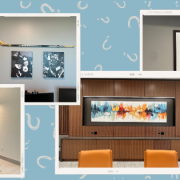Art, Nature, and Their Positive Effects on the Elderly
Great art does more than fill wall space or even tie a room’s visual aesthetic together. Great art possesses an emotional quality, and knowing what types of art best match the emotional purpose of a room can make the art selection process much easier.
For example, recent studies suggest that aging adults benefit greatly from being surrounded by paintings or images of nature – a fact that guided the Concepts in Art team for a recent project at a senior living community.
As humans age, they naturally lose their ability to participate in activities that once brought them joy – most of which involve some aspect of connecting with the physical world around them. Late-life depression affects about 6 million adults over 65 as losing the physical ability to independently participate in activities, like mowing the lawn, swimming, or even just going for a walk, can be a very isolating and upsetting experience.
The root cause of those upsetting feelings can be attributed to biophilia. Biophilia is the concept that all humans have an innate desire to connect with nature and the living world around them; it’s why taking a walk outside after a stressful day of work or opening a window during a rainstorm makes us feel better than before. As humans, we have a natural desire to connect with nature, and as we age we lose our ability to act on that desire.
However, there is a way for familial and professional caretakers to tend to the biophilic needs of older adults. Scientific studies have shown that exposure to imagery of nature can have a number of profound physiological and psychological benefits – especially for elderly individuals grappling with age-related ailments or cognitive decline.
First, serene depictions of a beautiful garden or powerful waterfall evoke a grounding feeling of calmness. In a phase of life where there is so much change and movement, nature-inspired artworks can create an air of tranquility by rooting the individual in a calming environment. Scenes of nature can also enhance cognitive function and memory retention in elderly individuals as intricate details stimulate the mind, fostering neural connections and cognitive engagement. For elderly individuals grappling with memory loss or cognitive decline, engaging with this kind of art can assist in the preservation of cognitive function and mental acuity.
Beyond its physiological and psychological benefits, this kind of art can foster a sense of connection and belonging among elderly individuals. Reminiscing about past outdoor adventures serves as a catalyst for meaningful social interactions and shared experiences. In retirement communities and assisted living facilities, nature-inspired artwork often becomes a focal point for communal gatherings and storytelling sessions, fostering a sense of camaraderie and belonging that is often lost as we age.
For elderly individuals who may have limited mobility or opportunities to explore the outdoors, nature art serves as a means of connecting with the natural world – something humans long for naturally. Certain types of art – like images of landscapes, wildlife, and plants – can contribute greatly to the overall purpose of any given space and knowing which types of art can evoke certain emotional responses can be a great tool in choosing the best piece for your space.






Leave a Reply
Want to join the discussion?Feel free to contribute!